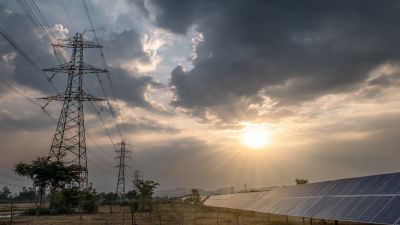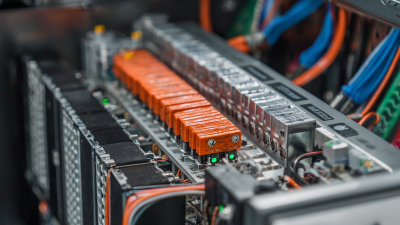SunVena Solar Blog
Residential Solar News, Insights & Resources
5 Essential Tips to Understand Solar Inverter Cost for Your Home
When considering the transition to solar energy for your home, one of the most critical factors to evaluate is the solar inverter cost. Solar inverters play a pivotal role in converting the direct current (DC) generated by your solar panels into alternating current (AC) that can be used by your household appliances. However, the costs associated with these essential components can vary significantly based on several factors, including the type and efficiency of the inverter, installation fees, and potential long-term savings on energy bills. In this blog, we will explore five essential tips to help you better understand the different aspects that contribute to solar inverter costs, enabling you to make an informed decision and maximize your investment in solar technology. Whether you are just starting your research or ready to install a solar system, this guide will equip you with the knowledge necessary to navigate the world of solar inverters effectively.

Understanding the Factors That Influence Solar Inverter Costs for Residential Homes
When considering solar inverter costs for residential homes, several key factors come into play that can significantly influence the overall price. First and foremost, the type of inverter selected plays a crucial role. There are mainly three types: string inverters, microinverters, and power optimizers; each comes with its own pricing structure and efficiency spectrum. String inverters are generally more affordable but may not perform well in shaded areas, while microinverters, though pricier, can optimize energy production in diverse conditions, ultimately impacting long-term savings.
Another significant factor is the size and capacity of the system. Larger systems capable of generating more power will naturally incur higher upfront costs. Installation complexities also contribute to the final cost; for instance, challenging roof configurations or the need for additional electrical upgrades can increase labor costs. Additionally, the brand reputation and warranty offerings should not be overlooked, as investing in a reliable brand with robust warranties may lead to better performance and lower maintenance costs in the long run, making it a worthwhile consideration for any homeowner planning to transition to solar energy.

Calculating the Return on Investment: Analyzing Energy Savings from Solar Inverters
When considering the installation of solar inverters for your home, understanding the return on investment (ROI) is crucial. According to the Solar Energy Industries Association (SEIA), the average homeowner can save between $10,000 and $30,000 over 20 years through energy savings. This significant financial benefit underscores the importance of choosing the right solar inverter, as they play a vital role in maximizing energy production and efficiency.
To enhance your understanding of solar inverter costs and their long-term financial impact, here are a few key tips:
- Assess your home’s energy consumption patterns. By understanding your energy needs, you can select an inverter that optimizes performance, potentially saving you thousands on electricity bills.
- Consider the inverter's lifespan and warranty options. A quality inverter typically lasts 5 to 10 years, with many manufacturers offering warranties of 10 to 25 years; ensuring longevity can further boost your ROI.
- Stay informed about federal and state incentives, such as tax credits and rebates, which can significantly lower your initial investment and enhance your overall savings.
Exploring Different Types of Solar Inverters: Costs vs. Benefits Breakdown
When considering solar inverter options for your home, it’s essential to understand the various types available and how they align with your energy needs and budget. The most common types are string inverters, microinverters, and power optimizers. String inverters are typically the most cost-effective choice for homes with uniform roof angles and sunlight exposure, making them a popular option for many households. However, they may struggle with efficiency in partially shaded environments.
On the other hand, microinverters offer individual panel-level optimization, which can significantly enhance overall energy production, particularly in homes with varying roof angles or shading issues. While they come with a higher initial cost, the benefits of increased energy generation often justify the expense over time. Power optimizers fall in between, combining benefits of both systems by enhancing the performance of individual panels while still using a central inverter. Assessing these options against their costs and potential savings in energy bills is crucial for making an informed decision that suits your home’s specific needs.
Understanding Solar Inverter Costs for Your Home
This chart illustrates the average costs associated with different types of solar inverters commonly used in residential installations. The costs can vary based on specific features and installation requirements.
Average Price Ranges: What Homeowners Can Expect to Pay for Solar Inverters
When considering solar energy for your home, one of the key components to understand is the cost of solar inverters. According to the Solar Energy Industries Association (SEIA), the average price of solar inverters ranges from $1,000 to $3,000, depending on the type, brand, and capacity. It's essential for homeowners to recognize that while initial costs may seem high, solar inverters play a crucial role in optimizing energy capture and can lead to significant savings on electricity bills in the long run.

Tip #1: Research different types of inverters. There are mainly three types: string inverters, microinverters, and power optimizers, each with its own price range and efficiency. Microinverters generally come with a higher upfront cost but offer better performance in shaded locations and can improve the overall efficiency of your solar system.
Tip #2: Understand installation costs. The cost of installation can vary widely, with average estimates between $500 and $1,500. It's important to factor this into your total budget as it can significantly affect your overall investment in solar energy. Engaging with reputable solar installation companies can help provide accurate quotes and potential financing options.
Evaluating Installation and Maintenance Costs for Solar Inverters in Your Home
When considering the installation of solar inverters in your home, understanding the associated costs of installation and maintenance is crucial. The global solar inverter market is projected to see substantial growth, rising from $46.57 billion in 2023 to approximately $209.74 billion by 2032, with a compound annual growth rate of 18.62% from 2024 to 2032. This trend underscores the increasing demand for energy-efficient solutions. Solar inverters play a pivotal role in solar energy systems by converting the direct current (DC) generated by solar panels into alternating current (AC), which is necessary for home use and grid integration.
In addition to installation costs, prospective solar users should also factor in ongoing maintenance expenses. A study by the Energy Efficiency and Conservation Authority emphasizes the importance of evaluating these costs against potential savings on energy bills. Homeowners are encouraged to weigh these considerations carefully, especially in regions where energy prices are rising or where government incentives can offset initial investments. Understanding these financial aspects will not only help in budgeting but also in making informed decisions about transitioning to solar energy, thus enhancing overall energy efficiency in the long run.
5 Essential Tips to Understand Solar Inverter Cost for Your Home - Evaluating Installation and Maintenance Costs for Solar Inverters in Your Home
| Cost Element | Estimated Cost Range | Notes |
|---|---|---|
| Solar Inverter Unit | $1,000 - $3,000 | Varies based on inverter type and efficiency |
| Installation Labor | $500 - $1,500 | Depends on installation complexity |
| Permits and Inspection Fees | $100 - $500 | Required in many areas for installation |
| Maintenance Costs | $100 - $300/year | Includes periodic inspections and cleaning |
| Replacement Costs (after 5-10 years) | $1,000 - $2,000 | Inverter typically lasts 5-10 years |
Related Posts
-

Mastering Your 3kw Solar Inverter Setup A Step by Step Tutorial for Beginners
-

Unlocking Energy Independence with Solar Power Inverter for Home Benefits
-

How to Choose the Right Solar River Inverter for Your Energy Needs
-

Innovative Examples of RV Solar Inverter Technologies Shaping Sustainable Travel
-

Mastering Your Solar System with the Best Must Solar Inverter Selection Guide
-

Mastering Hybrid Solar Inverters: A Comprehensive Guide to Boosting Energy Efficiency by 30%